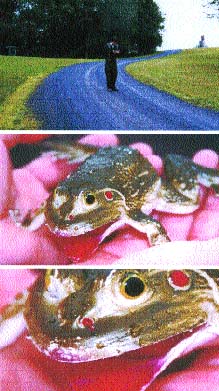 |
| Emilio
Fantin "Max's Dream", 2001 C-type print Courtesy the artist |
Emilio Fantin
Stefano
Pasquini
In the Bologna art scene Emilio Fantin is certainly an
enigmatic figure: the last work I saw of his was in a shut gallery:
nothing to see, just the sound of someone crying inside. He later told me
that he was recently working on "taking out" rather than adding. What else
can an artist take out if not the gallery itself? And is this not a good
enough reason to cry? This truly conceptual approach to contemporary art
makes him a difficult artist to sell or promote: he barely ever produces
marketable products and in all effects he is an invisible artist, in the
sense that unless you're lucky enough to experience one of his work or
action, you may never know of his existence.
Looking at his work, one
can tell that Emilio Fantin is profoundly influenced by philosophy in his
idea of art. He doesn't like the word communication, and in an interview
with Giorgina Bertolino he states "I soon realized that communication for
me meant something else. It actually meant 'else' - the other - the
relationship between me and that which is not me. This relation didn't
come through a need to relate to an audience but rather a philosophical
stance specifically regarding the relationship between subject and object.
In classical logic an assertion is a proposition formed by subject, verb
and object: through this kind of situation, the final sense of a statement
is determined. I worked on communication because I wanted to modify this
type of structure: not so much to determine an object through a verb, as
to place subject and object on the same level."
This was achieved in
the first work of his I saw. We were in a group show together at Art in
General where I heard "Private", a deja vu of Yoko Ono's telephone piece.
The phone rings at the opening, I pick it up, and the first thing I say is
that Yoko Ono did the same piece in 1969. To this day I don't know if
Fantin was aware of it at the time, but nevertheless the work does the
job, and this is particularly noticeable in the transcription of some of
the conversations: almost immediately the words spoken between the artist
and the receiver assume an aura of immortality: time stops for all and the
work is here and now. The conversation raises to a higher level, as it is
true that the will of communicating makes communication easier and deeper.
The work is the voice of the artist and the visitor, and they are its only
witnesses.
"Philosophy is like untangling wool. Pulling doesn't help.
And I'm inclined to pull", states a woolen sweater citing Wittgenstein.
And if we take for good the Aristotelian precept that "it is not possible
to think without images", Fantin knits the quotation on the woolen sweater
itself, and I can figure him out going around town with the sweater on,
classifying as art the thoughts of all the passerbys who read the writing.
Time comes also into play in "Autoritratto", a self portrait diptych of
the artist now and in his youth. What's in between can only be filled by
the artist through his memory and by the viewer through imagination, and
this is what make Fantin's work invisible: the work is not the two
portraits, it's what's (and what has been) between them. Like in a movie
where we missed the beginning we can only imagine what came to that point,
"the work of art today" wrote Fulvio Carmagnola, "is not an arcanum above
normal perceptions, but an object uncompleted by the artist which asks to
be completed by the active participation of the reader, the viewer, the
user."
"Comune a tutti e' sognare" (Dreaming is in common with
everyone) is the title of a poster from 1999, and dreams are a significant
part of Fantin's research. In "Sogna per me" (Dream for me) he asked
different people to dream in a set night and place, then recorded the
dreams, which he "showed" coming out of little holes in the wall of the
gallery.
An extension of this work is what he did at his residency at
Art Omi last summer: he restaged the dreams of his colleague artists and
then photographed them. The results are images of beautiful efficacy. They
make me wonder if Fantin's best achieved result is not just this: his
projection of ourselves inside his dreamworld, the moment that makes us
feel like we're falling through a fennel and inside his brain, only to
become part of one of his intricate thoughts.
